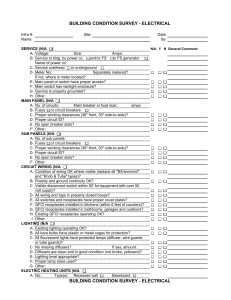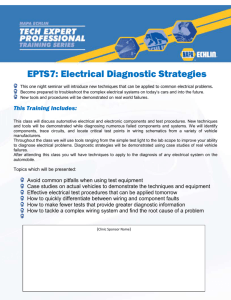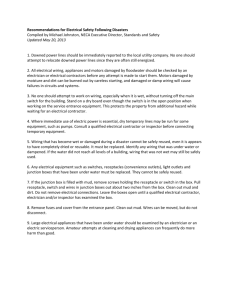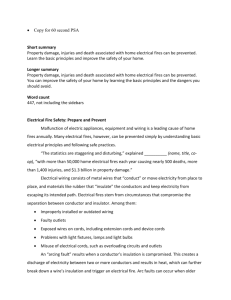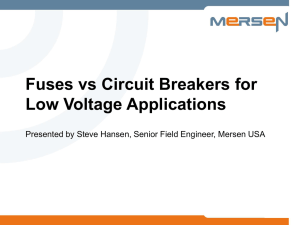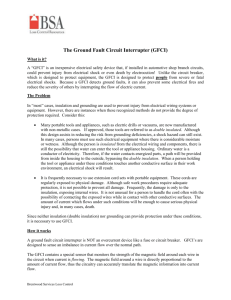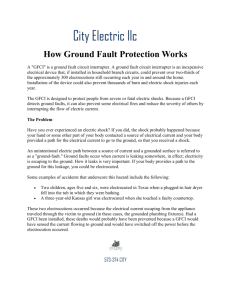Click to Print - Working RE Magazine
advertisement
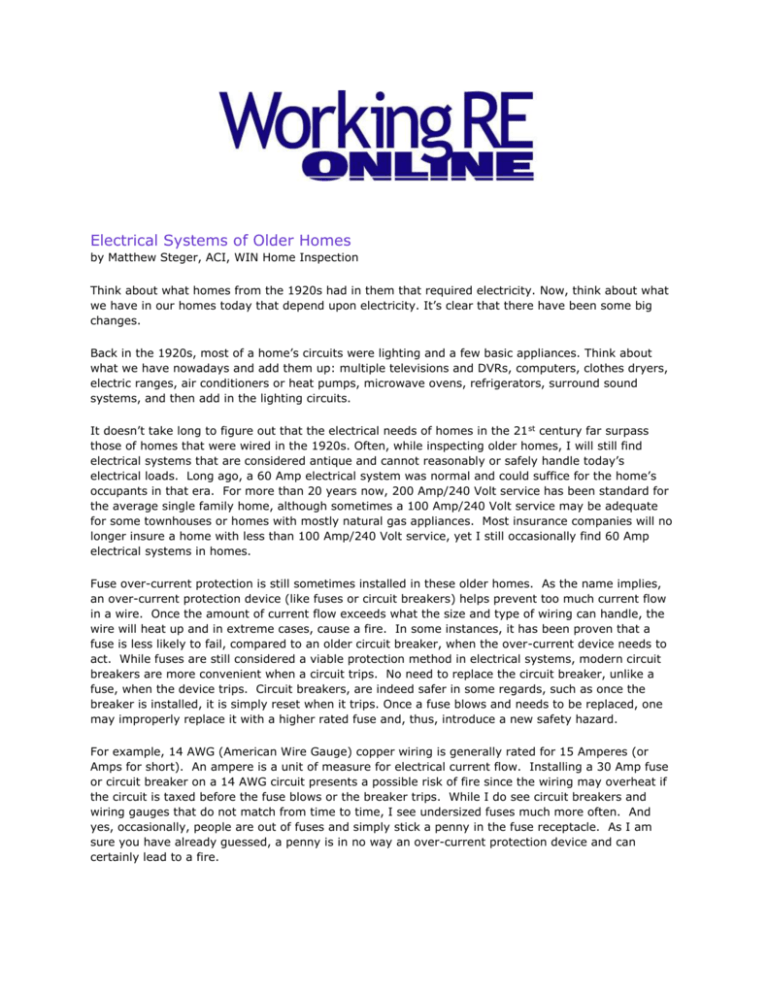
Electrical Systems of Older Homes by Matthew Steger, ACI, WIN Home Inspection Think about what homes from the 1920s had in them that required electricity. Now, think about what we have in our homes today that depend upon electricity. It’s clear that there have been some big changes. Back in the 1920s, most of a home’s circuits were lighting and a few basic appliances. Think about what we have nowadays and add them up: multiple televisions and DVRs, computers, clothes dryers, electric ranges, air conditioners or heat pumps, microwave ovens, refrigerators, surround sound systems, and then add in the lighting circuits. It doesn’t take long to figure out that the electrical needs of homes in the 21 st century far surpass those of homes that were wired in the 1920s. Often, while inspecting older homes, I will still find electrical systems that are considered antique and cannot reasonably or safely handle today’s electrical loads. Long ago, a 60 Amp electrical system was normal and could suffice for the home’s occupants in that era. For more than 20 years now, 200 Amp/240 Volt service has been standard for the average single family home, although sometimes a 100 Amp/240 Volt service may be adequate for some townhouses or homes with mostly natural gas appliances. Most insurance companies will no longer insure a home with less than 100 Amp/240 Volt service, yet I still occasionally find 60 Amp electrical systems in homes. Fuse over-current protection is still sometimes installed in these older homes. As the name implies, an over-current protection device (like fuses or circuit breakers) helps prevent too much current flow in a wire. Once the amount of current flow exceeds what the size and type of wiring can handle, the wire will heat up and in extreme cases, cause a fire. In some instances, it has been proven that a fuse is less likely to fail, compared to an older circuit breaker, when the over-current device needs to act. While fuses are still considered a viable protection method in electrical systems, modern circuit breakers are more convenient when a circuit trips. No need to replace the circuit breaker, unlike a fuse, when the device trips. Circuit breakers, are indeed safer in some regards, such as once the breaker is installed, it is simply reset when it trips. Once a fuse blows and needs to be replaced, one may improperly replace it with a higher rated fuse and, thus, introduce a new safety hazard. For example, 14 AWG (American Wire Gauge) copper wiring is generally rated for 15 Amperes (or Amps for short). An ampere is a unit of measure for electrical current flow. Installing a 30 Amp fuse or circuit breaker on a 14 AWG circuit presents a possible risk of fire since the wiring may overheat if the circuit is taxed before the fuse blows or the breaker trips. While I do see circuit breakers and wiring gauges that do not match from time to time, I see undersized fuses much more often. And yes, occasionally, people are out of fuses and simply stick a penny in the fuse receptacle. As I am sure you have already guessed, a penny is in no way an over-current protection device and can certainly lead to a fire. Inspecting Breaker Panels Older breaker panels also are a concern. Mechanical and electrical components tend to deteriorate with age. Some people are under the dangerous assumption that breaker panels and their components have an unlimited life expectancy; the rule of thumb in the home inspection industry is generally 30 years for these devices. When inspecting a home that has an electrical system over 30 years old, common practice is to recommend consulting a licensed and qualified electrician to evaluate the breaker panel to ensure it is still working as designed. Who knows if any of the circuit breakers have ever NEEDED to trip and didn’t. Home inspectors don’t remove circuit breakers from the panel, and it is possible that arcing or burn marks may exist but are hidden behind the breakers. These characteristics can be tell-tail signs of dangerous conditions. A qualified electrician can determine if these issues are occurring or have in the past. If no issues are apparent, this can help put a buyer’s mind a little more at ease. The type of wiring in the home can also be an issue. Up to the mid to late 1940s, knob and tube wiring (also sometimes called "K&T wiring") was common. Knob and tube wiring on its own is not inherently a problem. It becomes a problem, however, when modified by unqualified people. This type of wiring consists of two individual wires that are run independently and then joined where needed to power lighting, switches, and receptacles. Today’s wiring is commonly called Romex® or NM (non-metallic sheathed) cable and includes all of the conductors together in one sheathed piece of wiring. Today’s circuits should be grounded since modern Romex® wiring includes a bare copper ground wire. K&T wiring does not include a ground wire. K&T wiring is designed to be air cooled, which means there should be no insulation (or other materials) around this type of wiring. Also, the size of the knob and tube’s individual conductors may be inadequate in some circumstances to supply today’s electrical loads and, in my experience, tend to have unsafe junctions (either to other K&T wiring or even modern wiring). It’s not unheard of for K&T wiring to be missing its insulation, leaving exposed wire conductors within reach. Just imagine if you’re walking into an old basement and your head accidentally brushes up against two exposed knob and tube conductors. Can you say OUCH?!? That is after (AND IF) you get back up after being shot across the basement with the shock of your life. The photo above shows knob and tube (K&T) wiring entering a basement junction box. Reporting Knob and Tube Several well-known insurance companies will not insure homes with active K&T wiring. When I see K&T wiring, I use a voltage sniffer on both conductors to determine if they are still live (energized). If so, I take a photo to include in the home inspection report and make a note to the buyer and agent about its presence and explain its issues. I know of instances that buyers didn’t find out that they were being denied insurance coverage until the day of closing. I recommend buyers check with the carrier they are planning to use to verify coverage, and if need be, get quotes from several carriers that will insure K&T wired homes. Doing this right after the home inspection can save a buyer many headaches down the road. Also, older 2 wire (ungrounded type) receptacles should only be changed to modern three prong (grounded type) receptacles if the wiring between the fuse box or breaker panel and the receptacle is also replaced with modern wiring and properly grounded. Otherwise, an ungrounded three prong receptacle may present a future safety hazard. A ground conductor is necessary if you are plugging in appliances that have a three-prong plug, such as a refrigerator, computer, or surge protector. Some other things you may want to consider with old electrical systems is having a licensed electrician install Ground Fault Circuit Interrupter (GFCI) protection at receptacles in wet areas, such as bathrooms, kitchen counters, laundry rooms basements, and at exterior and garage receptacles. GFCI protection can be provided by a GFCI receptacle or a GFCI circuit breaker. A GFCI receptacle doesn’t need to be grounded to properly function, so GFCI devices can protect older 2 wire (pre-1965) Romex®. While the National Electrical Code (NEC) didn’t require GFCI protection until the 1970s in most areas of the country (starting at exterior receptacles), adding GFCI protection in the wet areas listed above can help prevent a shock. If a GFCI isn't installed properly, it may not provide intended functionality, so only a licensed electrician should perform this type of work. The 1st photo shows an installed GFCI circuit breaker. The 2nd photo shows a GFCI receptacle. This article isn’t meant to scare potential buyers from purchasing an older home, but rather to enlighten home inspectors, agents and buyers about the issues that may exist with the older home’s electrical system, especially if the electrical system hasn’t been updated in decades. Agents who routinely list older homes may want to keep these issues in mind and discuss them with their sellers prior to listing just to prepare them. About the Author Matthew Steger, owner/inspector of WIN Home Inspection, is a Certified Level 1 Infrared Thermographer and an ASHI Certified Inspector (ACI). He can be reached at: 717-361-9467 or msteger@wini.com. WIN Home Inspection provides a wide array of home inspection services in the Lancaster, PA area. Please be sure to support the advertisers who help bring you WRE Online www.homeinspectioninstitute.com http://www.orep.org/benefits.asp http://www.mckissock.com/CommonForms/SearchCourses/searchResults.aspx?PartnershipID=%2bP %2b2hF6GqXE%3d
